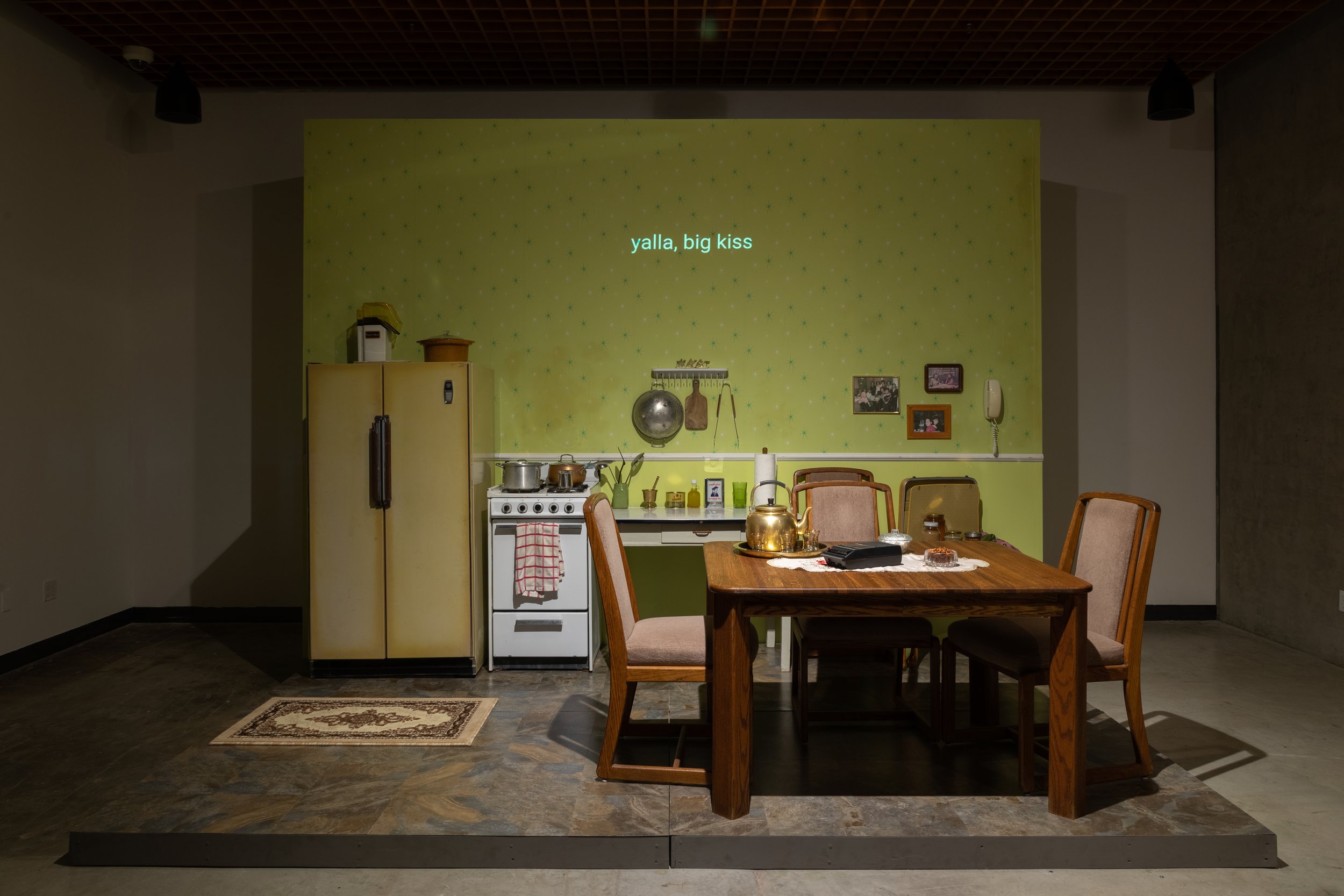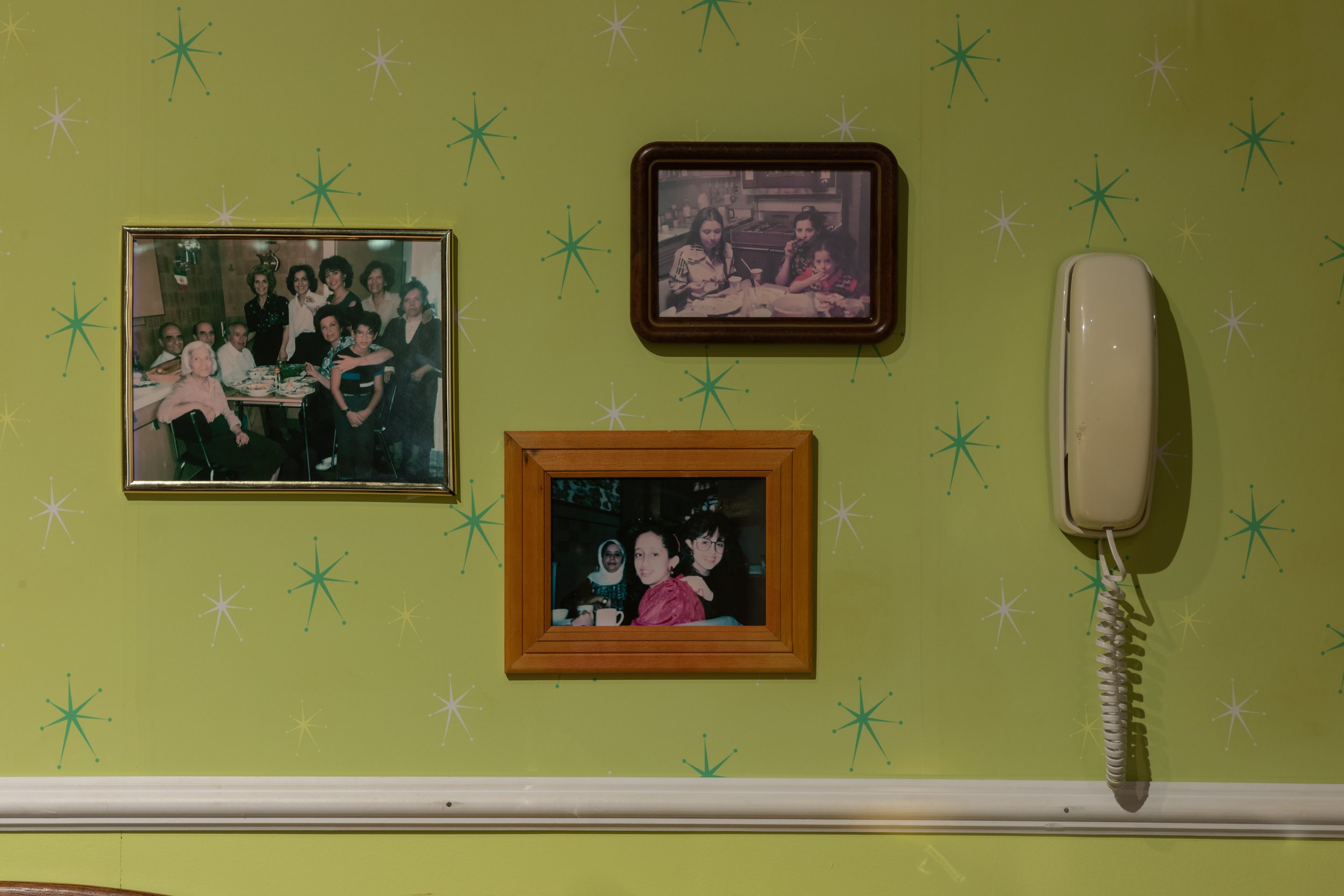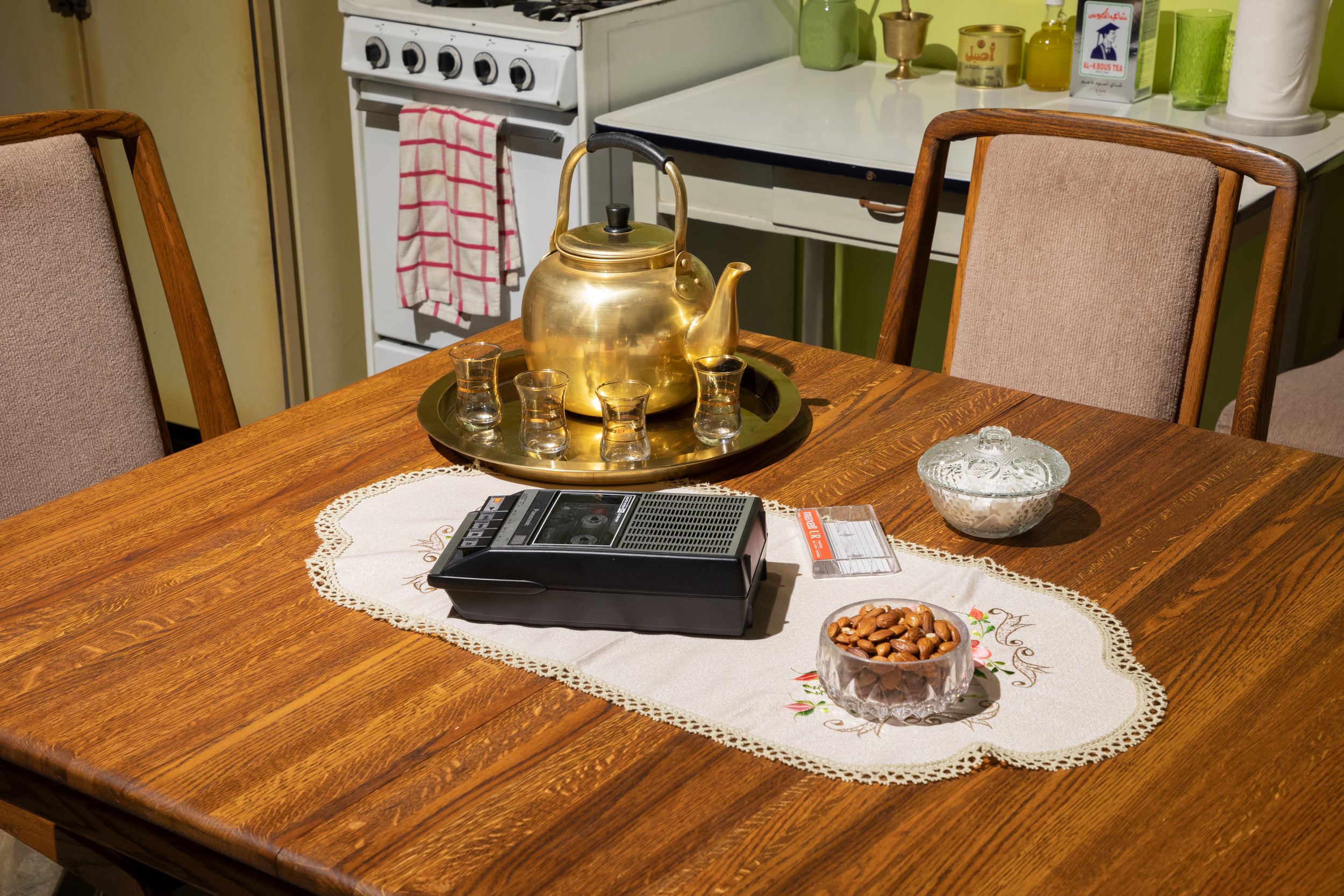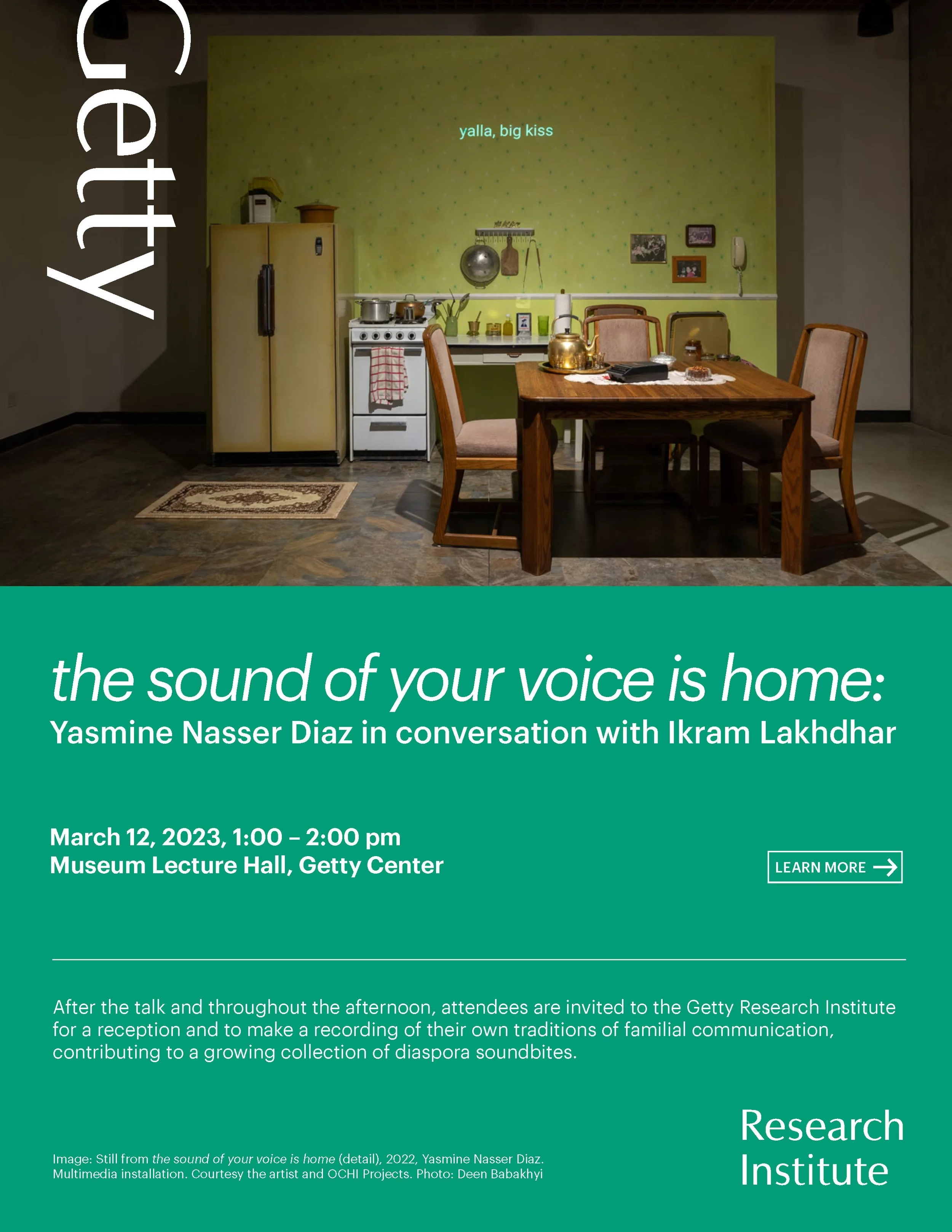






photo credit: Deen Babakhyi
the sound of your voice is home
Inspired by a family practice of exchanging audio cassettes between Chicago and Yafa, Yemen, Diaz’s installation, the sound of your voice is home, invites visitors into a space of ritual, gathering, and listening. The setting, an 80’s era kitchen, is a nod to her childhood and a time decades before the ubiquity of cell phones. Communicating with family in the highlands of southern Yemen from the U.S. was challenging. Only one house in the village had a telephone, making access and coordination difficult. In lieu of long-distance calls, her family would gather around the kitchen table to record lengthy audio messages on cassette tapes. The messages included updates on the health of relatives, news of engagements, pregnancies, births, and the latest gossip.
the sound of your voice is home, speaks to the evolving ways communities of diaspora maintain connectivity and affectionate exchanges while separated by time and distance. Playing on a loop is a collection of audio recordings in multiple languages gathered from friends, acquaintances, and family. They include recollections of familial practices as well as clips of recent WhatsApp voice messages between relatives. The stories shared reflect varying temporalities, from the past and present, further evoking the value of storytelling in producing and maintaining communal memories. The physical setting pays homage to the kitchen as the heart of the home and the core domestic space for conversation, nourishment, reconciliation, and care.
This project was made possible with support from the Foundation for Contemporary Arts.
Essay by Ikram Lakhdhar:
When our physical bodies can't travel to see loved ones, hearing their voices can echo straight to the heart. The sound of your voice is home (TSOYVIH) by artist Yasmine Nasser Diaz evokes a network of relational nostalgia and deep diasporic allegiance to the love language of auditory exchanges, past and present.
The artist has built a tangible communal archive, composed mostly of the Southwest Asian and North African (SWANA) diaspora, via a compilation of intimate audio clips sourced from friends and family. The thirteen-minute track plays within an installation of a 1980's era kitchen, with details reminiscent of the artist's childhood home. The voices of fourteen contributors can be heard speaking in multiple Arabic dialects, Farsi, Cantonese, and English, all of which have been translated into English subtitles that are projected onto the kitchen wall.
The bulk of this socially-engaged work was the time-consuming process of collecting, editing, and translating the audio. This act of translation is one of utmost cultural care. While translation provides a portal for how stories traverse language barriers, sometimes, a single misinterpreted word can change the meaning completely. Yasmine lends cultural specificity to TSOYVIH and the ways in which these filial stories are carried and are understood across cultures, time, and space.
The level of detail placed in curating the kitchen installation demonstrates a commitment to conscientious cultural representation. From the fresh "louz" (almonds) with the tea set to the brass mortar and pestle to the hidden transfuser of cumin scent, these objects, sourced from the artists' home, are iconic signifiers of every SWANA kitchen. The cassette tape occupies a central space in the installation, as if to suggest each person speaking were present and had a seat at the table. TSOYVIH allows visitors to receive these personal and familiar exchanges the way they were meant to be, raw and authentic for the ears and hearts of family members.
When the artist's family immigrated from Yemen to Illinois in the late 1960's, the communication technologies that the present generation blissfully takes for granted did not exist. "WhatsApp texts and voice memos are a kind of modern-day equivalent of the cassette tape exchanges," Yasmine explains. "TSOYVIH, to me, is a small gesture of preserving these exchanges and bridging the intergenerational parallels between them."
One of her sisters shares how their parents would sit around the kitchen table with tea, yelling at the kids to contribute to the hour-long updates for their family members in Yafa. Describing the etiquette of these cassette recordings, she details how their elders always began with lengthy poetic introductions of who they were addressing, as if they were painting a vivid portrait in lieu of being able to see them. TSOYVIH allocates archival value to these exchanges and the creative ways in which immigrant families honor time spent together and physically apart. Visitors are naturally compelled to recall their own families' communication strategies and how ancestral traditions are carried out and maintained over time.
The way Yasmine tells stories through her multi-sensory experiences is healing and somehow perforates any pre-perceived conceptions about diaspora, time, and home. Diaz is known to mix artistic mediums to build an affective world by and for the SWANA diaspora. Notably, Yasmine includes in a suitcase of home objects, pieces of fabric that she uses in her burnout paintings. This meta gesture can be explained as the artist's ode to her aesthetic lineage as we (the public) get a personal glimpse of her teenagehood and own body of archive.
As this work evolves, it would be interesting to grapple with questions of its afterlife, not just the migration of the sounds but the migration of the work as a whole. How will diasporas in different regions understand it and feel it? How are these stories carried through in time and place? Digesting and sitting with these learnings will help to inform Yasmine's ever-evolving body of work.
June 11 - July 24, 2022
ReflectSpace Gallery, Glendale Central Library
222 E. Harvard St, Glendale, CA
the sound of your voice is home, 2022
site-specific installation: found and acquired materials, dimensions variable
video (subtitles + sound) 12 min, 48 sec
audio mixing: Juliet Hinely
audio and video editing: Yasmine Nasser Diaz
translation editing: Jude Tarabulsi, Weng San Sit, Mohammad Golabi, and Lila Nazemian
installation construction: Trent Sneed
audio contributors: Ali Golabi (via Mohammad Golabi); Angeline Wong (via Weng San Sit); Hasan Ali Dabbouseh, Ishak Ali Dabbouseh, and Nehaya Dabbouseh (via Jude Tarabulsi); Julia Soto, Lila Nazemian, Lucy Der-Tawitian (via Anahid Oshagan); Moumen Eryani, Naila Abuali (via Diana Abouali); Nawal Nasser, Nouria Um Muhammad Murshed, Sumaya Abubaker
